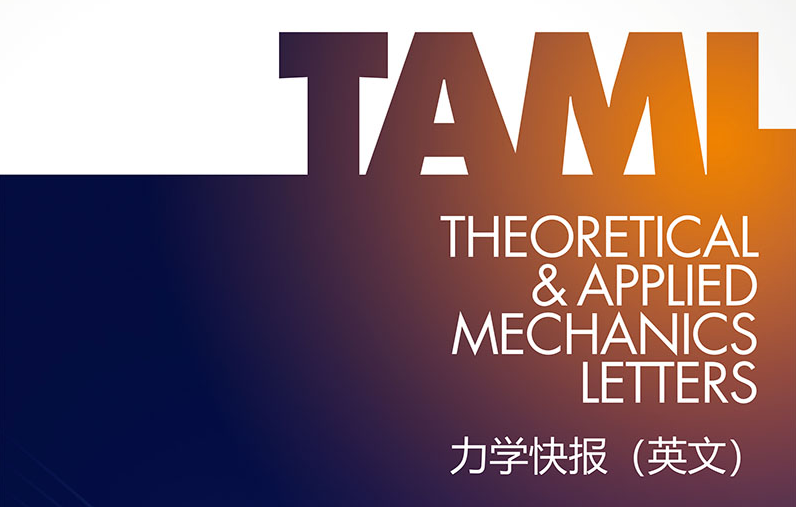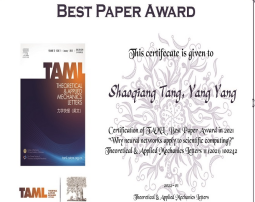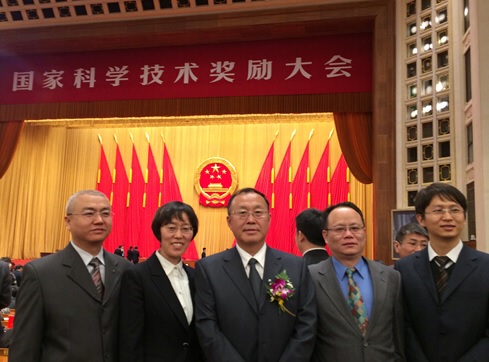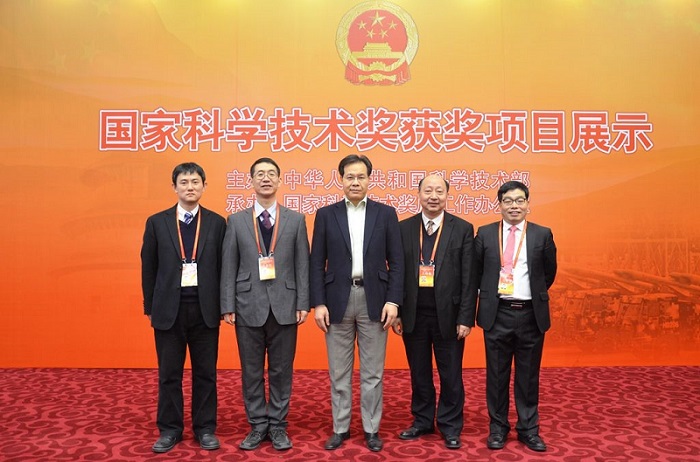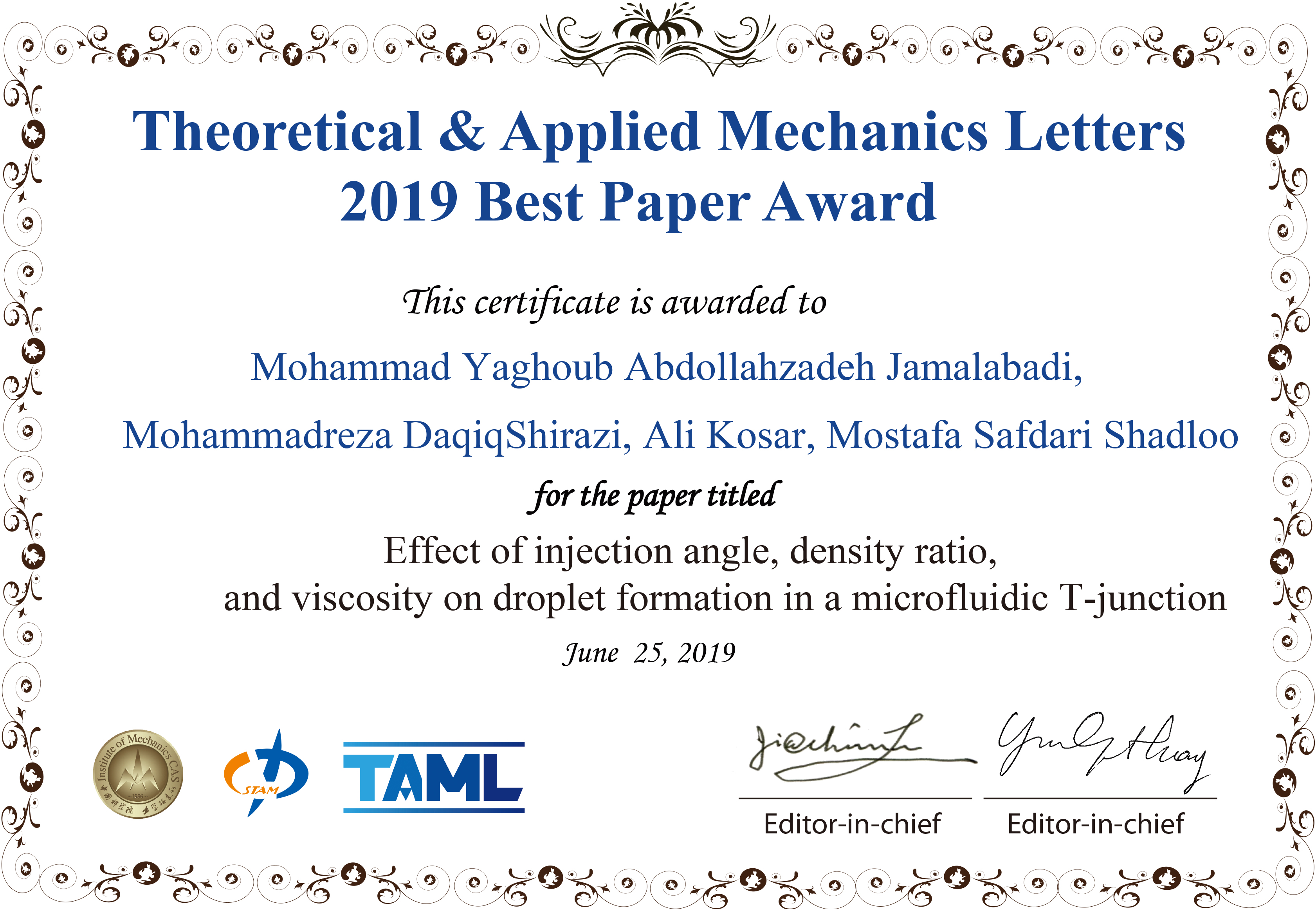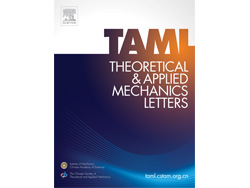Institute of Mechanics,
Chinese Academy of Sciences
2024 Vol.14(4)
Display Mode: |
Theoretical and Applied Mechanics Letters 14 (2024) 100507.
doi: 10.1016/j.taml.2024.100507
Abstract:
In this work, a bidirectional fluid‒structure coupling finite element analysis model of the abdominal aorta was established, with the various vascular elastic modulus as the main parameters for atherosclerosis, taking into consideration blood's dynamic viscosity and compressibility. Pressure and velocity pulse-wave propagation were investigated through the application of a full-coupling analysis algorithm. The effect of atherosclerosis degree on the propagation characteristics of pulse waves in the bifurcated abdominal aorta was quantitatively analyzed. Arterial bifurcation can cause substantial attenuation on the peak of pressure pulse waveform and an increase in wave velocity during the cardiac cycle. The elastic modulus and bifurcation properties of the arterial wall directly affected the peak value and wave propagation velocity of the pressure pulse wave. The preliminary results of this work will be crucial in guiding the evolution of the pressure pulse wave and the initial diagnosis of atherosclerotic disease through the waveform.
In this work, a bidirectional fluid‒structure coupling finite element analysis model of the abdominal aorta was established, with the various vascular elastic modulus as the main parameters for atherosclerosis, taking into consideration blood's dynamic viscosity and compressibility. Pressure and velocity pulse-wave propagation were investigated through the application of a full-coupling analysis algorithm. The effect of atherosclerosis degree on the propagation characteristics of pulse waves in the bifurcated abdominal aorta was quantitatively analyzed. Arterial bifurcation can cause substantial attenuation on the peak of pressure pulse waveform and an increase in wave velocity during the cardiac cycle. The elastic modulus and bifurcation properties of the arterial wall directly affected the peak value and wave propagation velocity of the pressure pulse wave. The preliminary results of this work will be crucial in guiding the evolution of the pressure pulse wave and the initial diagnosis of atherosclerotic disease through the waveform.
Theoretical and Applied Mechanics Letters 14 (2024) 100544.
doi: 10.1016/j.taml.2024.100544
Abstract:
Bone is a multi-phase, non-homogeneous material that exhibits strain rate sensitivity, and it may fail under compression, tension, torsion, or a combination of these loading. The mechanical properties of cortical bone with strain rate effect under compression and tension have been obtained through the application of the split Hopkinson pressure/tension bar technique, but no such studies have been reported for determining the strain rate behavior properties of bony materials under torsion. In this study, the shear stress-strain curves with the rate-dependent cortical bone subjected to dynamic torsional loading were first obtained using a torsional split Hopkinson bar system. Based on the experiments, an improved mathematical model consisting of elastic, viscoelastic, and viscoplastic components was used to identify the material parameters of the cortical bone. Detailed material properties are derived through constitutive relations. The results may assist researchers in developing more accurate models of cortical bone behavior under different load conditions.
Bone is a multi-phase, non-homogeneous material that exhibits strain rate sensitivity, and it may fail under compression, tension, torsion, or a combination of these loading. The mechanical properties of cortical bone with strain rate effect under compression and tension have been obtained through the application of the split Hopkinson pressure/tension bar technique, but no such studies have been reported for determining the strain rate behavior properties of bony materials under torsion. In this study, the shear stress-strain curves with the rate-dependent cortical bone subjected to dynamic torsional loading were first obtained using a torsional split Hopkinson bar system. Based on the experiments, an improved mathematical model consisting of elastic, viscoelastic, and viscoplastic components was used to identify the material parameters of the cortical bone. Detailed material properties are derived through constitutive relations. The results may assist researchers in developing more accurate models of cortical bone behavior under different load conditions.
Theoretical and Applied Mechanics Letters 14 (2024) 100545.
doi: 10.1016/j.taml.2024.100545
Abstract:
How the state of living muscles modulates the features of nonlinear elastic waves generated by external dynamic loads remains unclear because of the challenge of directly observing and modeling nonlinear elastic waves in skeletal muscles in vivo, considering their active deformation behavior. Here, this important issue is addressed by combining experiments performed with an ultrafast ultrasound imaging system to track nonlinear shear waves (shear shock waves) in muscles in vivo and finite element analysis relying on a physically motivated constitutive model to study the effect of muscle activation level. Skeletal muscle was loaded with a deep muscle stimulator to generate shear shock waves (SSWs). The particle velocities, second and third harmonics, and group velocities of the SSWs in living muscles under both passive and active states were measured in vivo. Our experimental results reveal, for the first time, that muscle states have a pronounced effect on wave features; a low level of activation may facilitate the occurrence of both the second and third harmonics, whereas a high level of activation may inhibit the third harmonic. Finite element analysis was further carried out to quantitatively explore the effect of active muscle deformation behavior on the generation and propagation of SSWs. The simulation results at different muscle activation levels confirmed the experimental findings. The ability to reveal the effects of muscle state on the features of SSWs may be helpful in elucidating the unique dynamic deformation mechanism of living skeletal muscles, quantitatively characterizing diverse shock wave-based therapy instruments, and guiding the design of muscle-mimicking soft materials.
How the state of living muscles modulates the features of nonlinear elastic waves generated by external dynamic loads remains unclear because of the challenge of directly observing and modeling nonlinear elastic waves in skeletal muscles in vivo, considering their active deformation behavior. Here, this important issue is addressed by combining experiments performed with an ultrafast ultrasound imaging system to track nonlinear shear waves (shear shock waves) in muscles in vivo and finite element analysis relying on a physically motivated constitutive model to study the effect of muscle activation level. Skeletal muscle was loaded with a deep muscle stimulator to generate shear shock waves (SSWs). The particle velocities, second and third harmonics, and group velocities of the SSWs in living muscles under both passive and active states were measured in vivo. Our experimental results reveal, for the first time, that muscle states have a pronounced effect on wave features; a low level of activation may facilitate the occurrence of both the second and third harmonics, whereas a high level of activation may inhibit the third harmonic. Finite element analysis was further carried out to quantitatively explore the effect of active muscle deformation behavior on the generation and propagation of SSWs. The simulation results at different muscle activation levels confirmed the experimental findings. The ability to reveal the effects of muscle state on the features of SSWs may be helpful in elucidating the unique dynamic deformation mechanism of living skeletal muscles, quantitatively characterizing diverse shock wave-based therapy instruments, and guiding the design of muscle-mimicking soft materials.
Theoretical and Applied Mechanics Letters 14 (2024) 100547.
doi: 10.1016/j.taml.2024.100547
Abstract:
The widely used human body injury criteria were established based on the biomechanical response of the Euro-American human body, without considering the differences in anthropometry and injury characteristics among different races, particularly the Chinese human body which typically has the smaller body size. The absence of such race specific design considerations negatively influences the injury prevention capability for these populations, and weakens the applicability of injury criteria. To resolve these issues, this study aims to develop a lower leg finite element model of a 50th percentile Chinese male. The model is built based on the medical images of an average size Chinese male with detailed ankle ligaments and lower leg muscles modeled. Data from sixty experiments available in the literature are used to validate its biofidelity. Using the validated model, the lower leg model is subjected to combined axial compression and bending loads to evaluate its injury criteria. Compared with a typical Euro-American human body mode, the Chinese lower leg presents reduced mechanical tolerance, and the revised tibia index may be an appropriate injury criteria for the Chinese lower leg. Additionally, the validated model reproduces the pedestrian lower leg fracture in a domestic accident.
The widely used human body injury criteria were established based on the biomechanical response of the Euro-American human body, without considering the differences in anthropometry and injury characteristics among different races, particularly the Chinese human body which typically has the smaller body size. The absence of such race specific design considerations negatively influences the injury prevention capability for these populations, and weakens the applicability of injury criteria. To resolve these issues, this study aims to develop a lower leg finite element model of a 50th percentile Chinese male. The model is built based on the medical images of an average size Chinese male with detailed ankle ligaments and lower leg muscles modeled. Data from sixty experiments available in the literature are used to validate its biofidelity. Using the validated model, the lower leg model is subjected to combined axial compression and bending loads to evaluate its injury criteria. Compared with a typical Euro-American human body mode, the Chinese lower leg presents reduced mechanical tolerance, and the revised tibia index may be an appropriate injury criteria for the Chinese lower leg. Additionally, the validated model reproduces the pedestrian lower leg fracture in a domestic accident.
Theoretical and Applied Mechanics Letters 14 (2024) 100548.
doi: 10.1016/j.taml.2024.100548
Abstract:
HighlightTo investigate the coupled damage mechanism of blunt impact and bullets penetration after penetrating ballistic plates against human body targets, experiments were conducted using 6.8 mm caliber armor-piercing bullets against gelatin targets with protective coatings. A numerical analysis model was developed to simulate bullet penetration into gelatin with protective coatings, obtaining endpoint characteristic quantities such as bullet velocity changes, changes in energy distribution, pressure, stress, and stress wave variations within the gelatin target after protection. The results indicate that at a velocity of 640 m·s-1, the 6.8 mm caliber armor-piercing round failed to penetrate the ballistic plate yet still caused a blunt impact depression of 37 mm in depth. Under conditions where the bullet did not penetrate the ballistic plate, approximately 80% of the bullet's kinetic energy was absorbed by the ballistic plate. At a velocity of 740 m·s-1, the bullet penetrated the ballistic plate, resulting in a blunt impact depression depth of 56 mm and an instantaneous cavity with a maximum diameter of 60 mm. During the process of penetrating the ballistic plate, approximately 50% of the bullet's kinetic energy was absorbed by the ballistic plate, and about 40% of the remaining kinetic energy transferred into the gelatin during the penetration of the target.
HighlightTo investigate the coupled damage mechanism of blunt impact and bullets penetration after penetrating ballistic plates against human body targets, experiments were conducted using 6.8 mm caliber armor-piercing bullets against gelatin targets with protective coatings. A numerical analysis model was developed to simulate bullet penetration into gelatin with protective coatings, obtaining endpoint characteristic quantities such as bullet velocity changes, changes in energy distribution, pressure, stress, and stress wave variations within the gelatin target after protection. The results indicate that at a velocity of 640 m·s-1, the 6.8 mm caliber armor-piercing round failed to penetrate the ballistic plate yet still caused a blunt impact depression of 37 mm in depth. Under conditions where the bullet did not penetrate the ballistic plate, approximately 80% of the bullet's kinetic energy was absorbed by the ballistic plate. At a velocity of 740 m·s-1, the bullet penetrated the ballistic plate, resulting in a blunt impact depression depth of 56 mm and an instantaneous cavity with a maximum diameter of 60 mm. During the process of penetrating the ballistic plate, approximately 50% of the bullet's kinetic energy was absorbed by the ballistic plate, and about 40% of the remaining kinetic energy transferred into the gelatin during the penetration of the target.
Theoretical and Applied Mechanics Letters 14 (2024) 100549.
doi: 10.1016/j.taml.2024.100549
Abstract:
This paper presents a method for measuring stress fields within the framework of coupled data models, aimed at determining stress fields in isotropic material structures exhibiting localized deterioration behavior without relying on constitutive equations in the deteriorated region. This approach contributes to advancing the field of intrinsic equation-free mechanics. The methodology combines measured strain fields with data-model coupling driven algorithms. The gradient and Canny operators are utilized to process the strain field data, enabling the determination of the deterioration region's location. Meanwhile, an adaptive model building method is proposed for constructing coupling driven models. To address the issue of unknown datasets during computation, a dataset updating strategy based on a differential evolutionary algorithm is introduced. The resulting optimal dataset is then used to generate stress field results. Validation against finite element method calculations demonstrates the accuracy of the proposed method in obtaining full-field stresses in specimens with local degradation behavior.
This paper presents a method for measuring stress fields within the framework of coupled data models, aimed at determining stress fields in isotropic material structures exhibiting localized deterioration behavior without relying on constitutive equations in the deteriorated region. This approach contributes to advancing the field of intrinsic equation-free mechanics. The methodology combines measured strain fields with data-model coupling driven algorithms. The gradient and Canny operators are utilized to process the strain field data, enabling the determination of the deterioration region's location. Meanwhile, an adaptive model building method is proposed for constructing coupling driven models. To address the issue of unknown datasets during computation, a dataset updating strategy based on a differential evolutionary algorithm is introduced. The resulting optimal dataset is then used to generate stress field results. Validation against finite element method calculations demonstrates the accuracy of the proposed method in obtaining full-field stresses in specimens with local degradation behavior.
Theoretical and Applied Mechanics Letters 14 (2024) 100539.
doi: 10.1016/j.taml.2024.100539
Abstract:
This study aimed to conduct finite element (FE) analysis matched with an in vitro experiment to analyze traumatic retinal detachments (TrRD) resulting from blunt trauma and provide stress and strain thresholds to predict the occurrence of TrRD. The in vitro experiment was performed on forty-eight porcine eyes using a pendulum device. We examined dynamic mechanical responses at four energy levels. A FE model, based on experimental results and published data, was used to simulate TrRD. Fifty-one additional eyes underwent immediate pathological examination following blunt impact. A dynamic variation of velocities was observed post-impact, displaying an approximate cosine oscillation-attenuation profile. Energy absorption increased as the initial energy and differed significantly at four energy levels (p < 0.001). FE simulation showed a peak strain of 0.462 in the anterior vitreous body and a peak stress of 1.408 MPa at the cornea at the high-energy level. During the energy transfer, the stress was initially observed in retinal region along the impact direction at the separation. TrRD were observed in injured eyes, where a few detachments were detected in control eyes. Correlations were performed between the proportion of pathological outcomes and FE results. In conclusion, this study suggests that stress contributes to the development of retinal detachment, providing an indicator to distinguish the occurrence of TrRD.
This study aimed to conduct finite element (FE) analysis matched with an in vitro experiment to analyze traumatic retinal detachments (TrRD) resulting from blunt trauma and provide stress and strain thresholds to predict the occurrence of TrRD. The in vitro experiment was performed on forty-eight porcine eyes using a pendulum device. We examined dynamic mechanical responses at four energy levels. A FE model, based on experimental results and published data, was used to simulate TrRD. Fifty-one additional eyes underwent immediate pathological examination following blunt impact. A dynamic variation of velocities was observed post-impact, displaying an approximate cosine oscillation-attenuation profile. Energy absorption increased as the initial energy and differed significantly at four energy levels (p < 0.001). FE simulation showed a peak strain of 0.462 in the anterior vitreous body and a peak stress of 1.408 MPa at the cornea at the high-energy level. During the energy transfer, the stress was initially observed in retinal region along the impact direction at the separation. TrRD were observed in injured eyes, where a few detachments were detected in control eyes. Correlations were performed between the proportion of pathological outcomes and FE results. In conclusion, this study suggests that stress contributes to the development of retinal detachment, providing an indicator to distinguish the occurrence of TrRD.
Theoretical and Applied Mechanics Letters 14 (2024) 100541.
doi: 10.1016/j.taml.2024.100541
Abstract:
This study investigates the three-dimensional (3D) effects introduced by the end walls for an aspect ratio of 1 in ramp-induced shock wave boundary layer interactions. The simulations are performed using a symmetry boundary condition in the spanwise direction at free-stream Mach numbers in 3D. The simulations are performed using an in-house compressible supersonic solver “OpenSBLIFVM”. Two free stream Mach numbers 2.5, and 3 are used in the current work, and the simulated results are compared with the aspect ratio 1 simulations by Mangalagiri and Jammy. The inflow is initialized with a similarity solution; its Reynolds number based on the boundary layer thickness is adjusted such that the Reynolds number at the start of the ramp is kept at for all simulations. From the results, it is evident that the introduction of sidewalls resulted in a shorter centerline separation length when compared with the two-dimensional (2D) simulations. This contradicts the results at Mach 2 by Mangalgiri and Jammy where the vortex observed at Mach 2 in the central separation region disappeared with increasing free-stream Mach number. Additionally, the topology of interaction shifted from owl-like separation of the second kind to the first kind when the freestream Mach number increased from 2 to 2.5. It can be concluded that the interaction topology is crucial to the increase or decrease of the central separation length when compared to 2D simulations.
This study investigates the three-dimensional (3D) effects introduced by the end walls for an aspect ratio of 1 in ramp-induced shock wave boundary layer interactions. The simulations are performed using a symmetry boundary condition in the spanwise direction at free-stream Mach numbers in 3D. The simulations are performed using an in-house compressible supersonic solver “OpenSBLIFVM”. Two free stream Mach numbers 2.5, and 3 are used in the current work, and the simulated results are compared with the aspect ratio 1 simulations by Mangalagiri and Jammy. The inflow is initialized with a similarity solution; its Reynolds number based on the boundary layer thickness is adjusted such that the Reynolds number at the start of the ramp is kept at for all simulations. From the results, it is evident that the introduction of sidewalls resulted in a shorter centerline separation length when compared with the two-dimensional (2D) simulations. This contradicts the results at Mach 2 by Mangalgiri and Jammy where the vortex observed at Mach 2 in the central separation region disappeared with increasing free-stream Mach number. Additionally, the topology of interaction shifted from owl-like separation of the second kind to the first kind when the freestream Mach number increased from 2 to 2.5. It can be concluded that the interaction topology is crucial to the increase or decrease of the central separation length when compared to 2D simulations.
Theoretical and Applied Mechanics Letters 14 (2024) 100542.
doi: 10.1016/j.taml.2024.100542
Abstract:
In this manuscript, Eshelby tensor is employed to assess the strain concentration that arises in the matrix phase at the interface, offering precise values and locations of maximum strain under specific loading conditions for both spherical and cylindrical inclusions. When compared to numerical simulation results, the analytical predictions grounded in the Eshelby tensor exhibit satisfactory accuracy. Then an analytical calculation method based on Eshelby tensor for the elastic strain influence functions of reduced-order homogenization (ROH) method is developed and adopted on particle-reinforced and fibrous composites, presenting its feasibility and advantage on off-line stage calculation of ROH method. The error analyses between analytical and numerical results are conducted. The numerical results also exhibit the necessity of finer interface partitioning to obtain the response on micro-scale with higher resolution.
In this manuscript, Eshelby tensor is employed to assess the strain concentration that arises in the matrix phase at the interface, offering precise values and locations of maximum strain under specific loading conditions for both spherical and cylindrical inclusions. When compared to numerical simulation results, the analytical predictions grounded in the Eshelby tensor exhibit satisfactory accuracy. Then an analytical calculation method based on Eshelby tensor for the elastic strain influence functions of reduced-order homogenization (ROH) method is developed and adopted on particle-reinforced and fibrous composites, presenting its feasibility and advantage on off-line stage calculation of ROH method. The error analyses between analytical and numerical results are conducted. The numerical results also exhibit the necessity of finer interface partitioning to obtain the response on micro-scale with higher resolution.
Theoretical and Applied Mechanics Letters 14 (2024) 100546.
doi: 10.1016/j.taml.2024.100546
Abstract:
Using origami folding concepts to design novel mechanical metamaterials has recently become a prevalent framework. Inspired by the Kresling origami structure, this study proposes a double-layer Kresling origami metamaterial with reprogrammable shock stiffness. Two combination strategies are constructed, each with different geometric constraints and kinematic compatibility. They are identified as assigned with same torsion direction (ASTD) and assigned with opposite torsion direction (AOTD), respectively. The shock stiffness of two double-layer Kresling origami metamaterials is analyzed using the finite element method, and results indicate that the AOTD metamaterial has superior impact resistance. Furthermore, the programmability of shock stiffness of the metamaterial is carried out comprehensively, and the influence of each design parameter is exhibited in detail. Finally, two prototypes of ASTD and AOTD metamaterials are fabricated, and experimental tests verify the analysis outcomes. This study provides a new approach to constructing mechanical metamaterials with reprogrammable shock stiffness for applications in energy absorption and vibration isolation engineering.
Using origami folding concepts to design novel mechanical metamaterials has recently become a prevalent framework. Inspired by the Kresling origami structure, this study proposes a double-layer Kresling origami metamaterial with reprogrammable shock stiffness. Two combination strategies are constructed, each with different geometric constraints and kinematic compatibility. They are identified as assigned with same torsion direction (ASTD) and assigned with opposite torsion direction (AOTD), respectively. The shock stiffness of two double-layer Kresling origami metamaterials is analyzed using the finite element method, and results indicate that the AOTD metamaterial has superior impact resistance. Furthermore, the programmability of shock stiffness of the metamaterial is carried out comprehensively, and the influence of each design parameter is exhibited in detail. Finally, two prototypes of ASTD and AOTD metamaterials are fabricated, and experimental tests verify the analysis outcomes. This study provides a new approach to constructing mechanical metamaterials with reprogrammable shock stiffness for applications in energy absorption and vibration isolation engineering.
 Submit a Paper
Submit a Paper
 Subscription
Subscription
News
MORE+
Call for Papers
MORE+
- Crossing-Mechanics Driven by Big Data
- Machine learning in the fluid mechanics research of wind energy
- Mechanics of Origami/Kirigami structures and metamaterials
- New insights and perspectives on impact biomechanics for human tissues: from injury prevention, protection to protective equipment
- Environmental Mechanics for Extreme Natural Events





